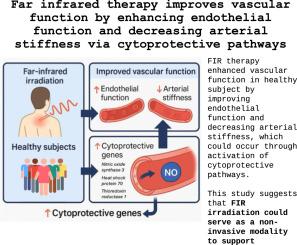Far infrared therapy improves vascular function by enhancing endothelial function and decreasing arterial stiffness via cytoprotective pathways
IF 8.2
2区 生物学
Q1 BIOCHEMISTRY & MOLECULAR BIOLOGY
引用次数: 0
Abstract
Background
Far-infrared radiation (FIR), an invisible part of the electromagnetic spectrum, is recognised for its potential therapeutic effects, particularly in promoting cardiovascular health. It has been proposed that FIR therapy enhances endothelial function and reduces arterial stiffness—both key markers of cardiovascular integrity. This study aims to elucidate the underlying mechanisms by which FIR therapy influences vascular function, specifically examining its impact on redox-associated gene expression and vascular responses in healthy subjects.
Methods
In this single-blinded, pilot study, 50 healthy participants were subjected to receive either FIR radiation, heat treatment or a placebo treatment to the upper back. Vascular function was assessed by measuring endothelial function using laser Doppler imaging with iontophoresis and assessing arterial stiffness via SphygmoCor. Gene expression analysis was performed on peripheral blood mononuclear cells (PBMCs), focusing on redox-associated cytoprotective genes and nitric oxide synthase (NOS).
Results
FIR radiation led to a significant enhancement in endothelial function and a reduction in arterial stiffness in healthy individuals. Gene expression analyses demonstrated an upregulation of cytoprotective genes, including NOS3, TXNRD1 and HSP70, post-FIR radiation.
Conclusions
FIR radiation has been shown to effectively enhance vascular function by improving endothelial function and decreasing arterial stiffness, which likely occurs through activation of cytoprotective pathways. This study suggests that FIR therapy could serve as a non-invasive modality to support cardiovascular health. These results offer valuable biochemical insights into the vascular protective effects of FIR and highlight its potential as a therapeutic strategy for cardiovascular disease prevention.
Objective
Aim: The primary aim of this study is to investigate the effect of localised FIR radiation on vascular function, in particular, endothelial function and arterial stiffness in healthy subjects. Endothelial function was examined using LDI combined with the iontophoresis of ACh and SNP, and using circulatory biomarkers for endothelial cells function and oxidation, while arterial stiffness was assessed through the AI@75 %. Hypothesis: The hypothesis of this study is that FIR confers beneficial effects on endothelial function and arterial stiffness through antioxidative and anti-inflammatory mechanisms, mediated in part by the upregulation of cytoprotective genes.

远红外治疗通过细胞保护途径增强内皮功能和降低动脉僵硬来改善血管功能。
背景:远红外辐射(FIR)是电磁波谱中不可见的部分,被认为具有潜在的治疗作用,特别是在促进心血管健康方面。研究表明,FIR治疗可以增强内皮功能,降低动脉僵硬度,这两者都是心血管完整性的关键指标。本研究旨在阐明FIR治疗影响血管功能的潜在机制,特别是研究其对健康受试者氧化还原相关基因表达和血管反应的影响。方法:在这项单盲先导研究中,50名健康参与者接受FIR辐射、热处理或上背部安慰剂治疗。血管功能通过离子导入激光多普勒成像测量内皮功能和sphygmoor评估动脉僵硬度来评估。对外周血单核细胞(PBMCs)进行基因表达分析,重点关注氧化还原相关的细胞保护基因和一氧化氮合酶(NOS)。结果:在健康个体中,FIR辐射可显著增强内皮功能并降低动脉僵硬度。基因表达分析显示,在fir辐射后,细胞保护基因(包括NOS3、TXNRD1和HSP70)上调。结论:FIR辐射已被证明通过改善EF和降低动脉僵硬来有效增强血管功能,这可能是通过激活细胞保护通路实现的。这项研究表明,FIR治疗可以作为一种非侵入性的方式来支持心血管健康。这些结果为FIR的血管保护作用提供了有价值的生化见解,并突出了其作为心血管疾病预防治疗策略的潜力。目的:本研究的主要目的是研究局部FIR辐射对健康受试者血管功能,特别是内皮功能和动脉僵硬的影响。使用LDI结合ACh和SNP离子电泳检测内皮功能,并使用循环生物标志物检测内皮细胞功能和氧化,同时通过AI@75%评估动脉僵硬度。假设:本研究的假设是FIR通过抗氧化和抗炎机制对内皮功能和动脉硬化产生有益作用,部分由细胞保护基因上调介导。
本文章由计算机程序翻译,如有差异,请以英文原文为准。
求助全文
约1分钟内获得全文
求助全文
来源期刊

Free Radical Biology and Medicine
医学-内分泌学与代谢
CiteScore
14.00
自引率
4.10%
发文量
850
审稿时长
22 days
期刊介绍:
Free Radical Biology and Medicine is a leading journal in the field of redox biology, which is the study of the role of reactive oxygen species (ROS) and other oxidizing agents in biological systems. The journal serves as a premier forum for publishing innovative and groundbreaking research that explores the redox biology of health and disease, covering a wide range of topics and disciplines. Free Radical Biology and Medicine also commissions Special Issues that highlight recent advances in both basic and clinical research, with a particular emphasis on the mechanisms underlying altered metabolism and redox signaling. These Special Issues aim to provide a focused platform for the latest research in the field, fostering collaboration and knowledge exchange among researchers and clinicians.
 求助内容:
求助内容: 应助结果提醒方式:
应助结果提醒方式:


